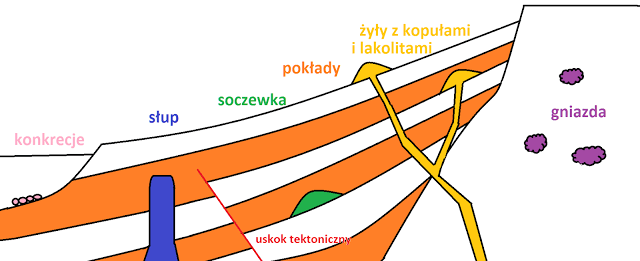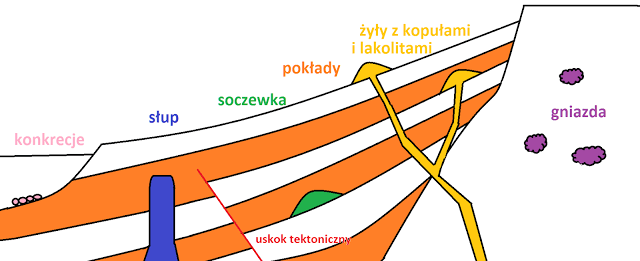Classification of mineral deposits
The deposits are divided into three main types:
- magmogenic deposits
- hypergenic deposits
- metamorphogenic deposits
Magmogenic deposits originate from magmatic activity. We distinguish igneous deposits , resulting from solidified magma and the crystallization of its components (iron ore, nickel, copper); post-igneous deposits , where crystallization occurs with the help of aqueous solutions (precious stones, zinc ores, lead, tin, barite) and volcanogenic deposits in volcanic eruptions (andesite, basalt, sulfur).
Hypergenic deposits are divided into weathering deposits , where the driving force is different types of erosion (bauxites); sedimentary deposits in depressions of the terrain or at the bottom of water reservoirs (evaporative – anhydrite, salt, gypsum) and biogenic deposits , i.e. those that come from organic matter transformed by pressure and temperatures (coal, oil and natural gas, limestone). This group of deposits is the most easily available, and therefore the most exploited.
The last group of deposits is divided into metamorphic , similar to biogenic, but the rocks are transformed and metamorphised , i.e. re-transformed one of the earlier.
We can distinguish four main types of extracted resources:
- energy: crude oil and natural gas, coal, peat
- metallic: iron ore, bauxite, shale, copper ore
- chemical: sulfur, salt, phosphate rock, dolomite
- construction: sands, clays, gravels, chalk, gypsum, limestone, marl
Methods of deposit retention

Concretions arise from minerals growing into the nucleus. A similar process occurs when pearls in clams form. In this way we obtain, for example, flints, phosphates, polymetallic concretions on the ocean floor.
Poles or dumps are typical sedimentary deposits, but due to tectonic movements they are pushed vertically from the lower layers. Salt is the most common raw material found in poles.
Seams are formed in the sedimentation process. This is where coal, manganese, copper, iron and salt come from. In the same way, lenses are formed when sedimentation is not even over the entire surface. Ores have deposits in the lenses.
Veins are minerals that fill gaps in rocks, for example gold and pyrite.
Nests is an aggregate of irregularly shaped mineral. These are bauxite.
On the bottom of rivers and some permanent reservoirs where currents occur, you can find so-called gold or diamond-bearing sands. These are sedimentary rocks with deposits that are leached from the ground. Metals that are heavier wash out more slowly and resist a decrease in watercourse or electricity.


0 Comments for “Mineral deposits and types of retention”